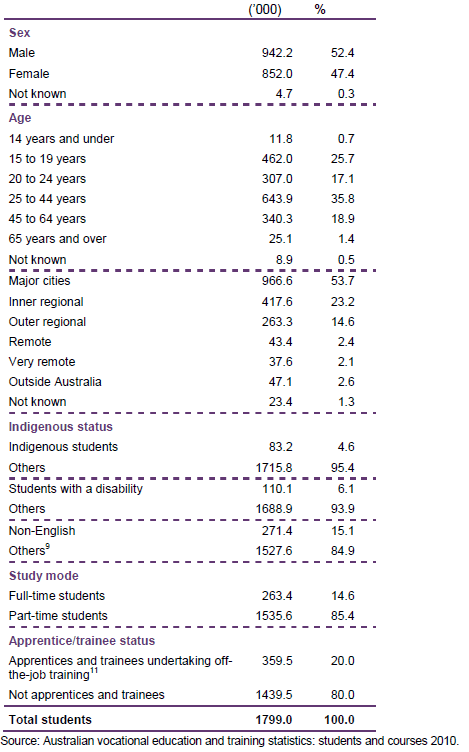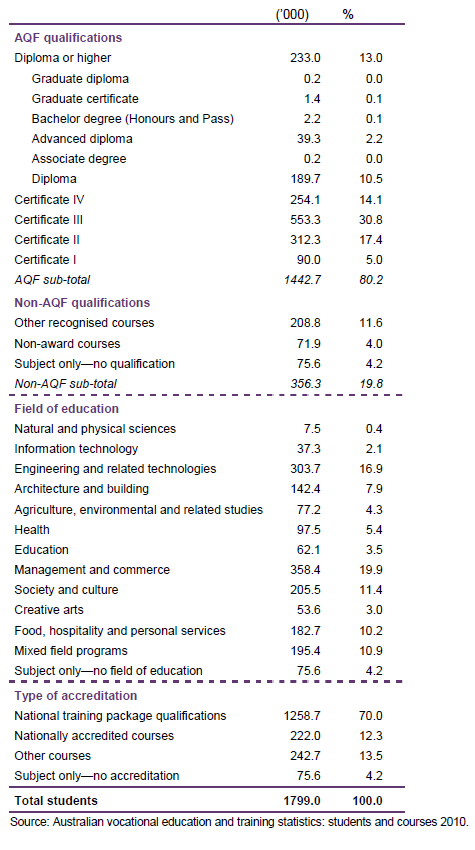Opinion piece
By Tom Karmel
Open to Ideas, published by the Associate Parliamentary Skills Group
Vocational education and skills is not a term that is used in Australia. Rather we talk about vocational education and training (VET), although other terms have been used including technical and further education, and vocational training and education. VET is surprisingly difficult to define in the Australian context. An obvious characterisation would be education and training with an occupational focus, but this does not distinguish it from higher education which provides occupational training for a wide range of occupations such as medicine, engineering and accounting to name a few. To restrict the notion of VET to sub-professional occupational training would not be useful because of changing qualification requirements for many occupations. Credential creep has seen many occupations requiring degrees as an entry qualification where lower level qualifications were previously sufficient. Qualification levels are a possibility, but under the Australian Qualification Framework diplomas are delivered in both VET and higher education, as are post-graduate diplomas and certificates. An institutional framework also does not provide a clean delineation, with the majority of universities registered to deliver VET qualifications, a number of dual sector institutions (the Royal Melbourne Institute of Technology, for example) operating in both sectors and a few Technical and Further Education (TAFE) institutes delivering higher education degrees. All in all, VET in Australia cannot be tidily defined.
What we can do, however, is point to some distinctive features of VET in Australia:
- It is centred around certificates I-IV, diplomas and advanced diplomas. To give this some context, the certificate III is the central qualification for trade training, and certificate IV generally introduces managerial competencies. Advanced diplomas are broadly comparable (at least in effort) to two years of a bachelors degree.
- It covers almost all fields of education, with the exception perhaps of the physical sciences. Its target occupations cover all occupational groups apart from the professions. While VET is described in occupational or industry terms, most of it (the trades and caring occupations being the exception) is generic in nature, if not intent, with a very loose match between the training and the occupations in which the graduates end up working.
- Courses are based on competencies specified in 'training packages'. These packages are developed by Industry Skills Councils and centrally endorsed through a national committee, the National Skills Standards Council. The packages provide guidance on the skills to be learnt and assessed, but do not set out how the training should be delivered.
- Pedagogy is distinctive, with competency-based training delivered in classrooms, remotely and in the work place. Classroom delivery typically involves small classes, unlike universities where lectures are delivered in some cases to many hundreds of students.
- An important element of VET is the delivery of the training component of apprenticeships and traineeships, although apprentices and trainees make up less than a quarter of students.
- The student body is very broadly based in comparison to universities, with a preponderance of part-time students, large numbers of older students, and high representation from disadvantaged groups.
- Funding and accountability is quite separate from the higher education system, reflecting Australia's federal system more than any innate logic.
- Students in publicly funded places pay relatively low tuition fees; otherwise they pay full commercial fees (although income contingent loans are available for diplomas).
The VET industry consists of over 5,000 registered training organisations, varying from niche providers to large TAFEs such as Sydney Institute with 60,000 students. Historically these providers were regulated by authorities in each state or territory, but this is changing with the creation of a national body, the Australian Skills Quality Authority (to which all states except Victoria and West Australia have referred powers). Tables 1 and 2 provide a snapshot of the publicly funded part of the sector. Official statistics are not available for the full-fee places at non-government providers, but a number of estimates put that part of the sector at over 40% of overall provision.
VET reform
The fundamental reforms to the sector occurred in the early 1990s with the introduction of competency-based training driven by national industry based skills councils. The other fundamental reform was the 'marketisation' of the sector – a transition from TAFEs that were essentially extensions of state education departments to a market in which over 5000 providers compete for government funding, as well as for students. The earliest manifestation of this shift was the introduction of 'user choice' for apprenticeships and traineeships which allowed employers to choose any registered training organisation to deliver the formal training component of the apprenticeship or traineeship.
While these changes are now embedded, governments continue to stress the need for further reform. The recent Council of Australian Governments Meeting communiqué of 19 August 2011 Revitalising the National Vocational Education and Training System sets out the latest official pronouncements. The main ingredients of the directions mooted in the communiqué are:
The desirability of moving towards a demand-driven system with greater contestability of funding for publicly funded training and greater competition between providers. Demand driven means that either students or enterprises can choose their registered training provider. Contestability means that the government TAFEs will not be guaranteed market share, although their role in addressing disadvantage privileges them to some extent. While the rhetoric is about competition, the delivery of publicly subsidised training is not a real market, with the government setting its contribution to the cost of delivery and putting strict rules around any additional tuition fees. One issue is the extent to which demand is specified through an entitlement or whether it is capped or constrained in some way. The Victorian entitlement model, arguably the purist exemplar of a demand-driven model at the moment, allows anyone to enrol in any course and get a public place if the course is at a higher level than the highest qualification the person already has. By contrast, in the South Australian model the program is driven largely by student demand, but the government reserves the right to apply caps and incentives to help 'manage' the market. One suspects that any government would be somewhat nervous of a pure entitlement model because of the potential for a budget blow out.
More higher-level qualifications. All evidence points to higher level qualifications (that is, diplomas and degrees) having better employment and wage outcomes than certificates. Thus there has been a push for some years to increase the number of diplomas that are delivered. At the same time, the government has set ambitious targets for the proportion of the population with a degree (40% of 25-34 year olds). These two policy goals may not be consistent because diploma and degree graduates tend to compete for the same jobs, and the evidence is that employers tend to favour degrees over diplomas. On the other hand, if diplomas become more of a pathway than a terminal qualification perhaps increases in provision of diplomas can co-exist with the expansion of higher education. In fact, the communiqué does refer to the importance of pathways between the sectors.
Greater transparency. Transparency is code for a number of developments revolving around information to inform consumer choice and provide public accountability. Current gaps that are being worked on include the collection of comprehensive data for the whole VET sector rather than just for the publicly funded part of it, and the publication of performance information by provider. The former will be effected by making the provision of data a mandatory requirement of a training organisation's registration – not something that is popular with private providers. The latter would bring the VET sector into line with what has been happening in the school and higher education sectors, and again is likely to be controversial among providers. The current investigation into the introduction of a unique student identifier also falls under the need for greater transparency.
Improved quality. New regulatory arrangements have been introduced in both VET and higher education, primarily as a result of the collapse of a number of providers of education to international students. Thus there are two new national regulators: the Australian Skills Quality Agency, mentioned earlier, for the VET sector and the Tertiary Education Quality and Standards Authority for higher education. The stated intention is to bring these two bodies together in 2013 – although the very different cultures of the two sectors will make this difficult. One area that is explicitly mentioned in the communiqué is 'teacher development'. Again this needs to be translated for a lay audience. Unlike the school sector where an education degree is mandated, the minimum qualification for teaching in VET is a certificate IV in training and assessment. This qualification does not have to be obtained before commencing teaching. Indeed, a teacher can work under supervision of someone with this qualification. The preponderance of casual teachers makes this issue particularly salient. The Productivity Commission (the government's primary office for advising on economic reform) has already reported on this issue and further policy work is to be expected, most likely driven by either the Australian Skills Quality Agency (as the national regulator) or the National Skills Standards Council (with its responsibility for standards).
While not specifically mentioned in the communiqué there are two particular features of the Australian VET sector that have made it difficult to manage quality across the sector. These are the absence of external assessment or validation and the focus on skills rather than time served. Both of these emanate from the competency philosophy. In respect of the former, the role of the trainer is to ensure that the student is competent in the appropriate range of skills contained in a qualification; the role is not to prepare the student for examination. Similarly the focus on competencies implies that time served is irrelevant; what counts is whether the person is competent or not. However, this philosophy has led to cases in which diplomas, for example, are delivered over a weekend— it is difficult to see how high quality training could have been provided in such cases. Regulation has focused on compliance with process rather than testing outcomes. These issues are very much alive in policy debates and it is to be expected that considerable attention will be paid to how assessment can be validated or moderated to ensure that poor quality training is stamped out.
Final comments
While recent reforms may not be in the same league as the move to industry-based competencies, their import should not be underestimated. Certainly, greater marketisation (allied to the concept of entitlement) is very significant. But also the move to greater transparency through more complete data and the publication of provider level indicators is a fundamental change to the way the sector has been managed. The sharper focus on quality is very welcome.
Table 1 Student characteristics, publicly funded vocational education and training in Australia, 2010

Table 2 Students by major courses and qualifications, publicly funded vocational education and training in Australia, 2010

Tom Karmel is the Managing Director of the National Centre for Vocational Education Research